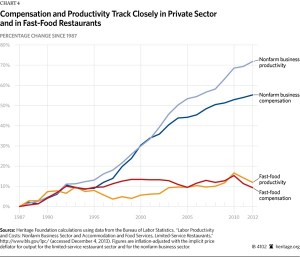Elizabeth Warren has a special talent for making her economic commentary go viral. Her rant that “nobody in this country got rich on their own” gained such popularity that Obama tried to mirror them with his own, disastrous “you didn’t build that” comment. There’s even a Wikipedia page on the gaffe’s influence.
Videos by Rare
That particular rant occurred and went viral while Warren was still a mere candidate for Senate. Today, Warren is a senator who knows how to use her platform. There are three particular claims of hers that merit attention here: that the minimum wage today should be $22 an hour, that banks can borrow at 0.75% interest while students pay 7%, and that the Federal government profits from student loans.
Myth #1: Who’ll give me $22 an hour?
Conservatives often like to caricaturize the logic of a minimum wage hike. If a hike to $10 is ideal, why not stop there? Why not fifteen dollars an hour, or twenty dollars an hour?
Except when Warren makes remarks about hiking the minimum wage to twenty dollars an hour, she isn’t being sarcastic. She stated during a hearing for the Senate Committee on Health, Education, Labor and Pensions: “If we started in 1960 and we said that as productivity goes up, that is as workers are producing more, then the minimum wage is going to go up the same. And if that were the case then the minimum wage today would be about $22 an hour.”
She continued by asking rhetorically, “with a minimum wage of $7.25 an hour, what happened to the other $14.75? It sure didn’t go to the worker.”
The actual study she was citing for this fact gave a range of possible estimates for what a productivity adjusted minimum wage would look like. These possible wages ranged from $9.22 to $21.72, so naturally, Warren took the highest number, rounded it even higher, than cited it as an objective fact.
There’s something else that Warren is overlooking. All productivity gains are not equal by sector. The technology sector has exploded over the past 20 or 30 years, but how many more hamburgers can a McDonald’s employee flip compared to decades ago? How many more shirts can a retail employee really sell?
To better visualize the gap between the general economy and the sectors in which minimum wage employees are employed, charted below is the gap in productivity gains in the entire economy vs. gains in food services.
This chart doesn’t begin its measurements in 1960 like Warren does, but it gets the point across. Productivity in the type of sectors that minimum wage earners work in has, for the most part, corresponded with compensation (wage + benefit) increases. In fact, the gap between a fast food employee’s productivity and their compensation is lower than in the economy as a whole.
Myth #2: Checking big banks’ privilege
How much interest should students pay on their student loans? The answer from Warren: 0.75% — a rate lower than the rate of inflation. Obviously, no private bank would loan out at this rate since they would lose money with inflation factored in, but she does think that the Federal government should give out loans at this rate.
Why? According to Warren “right now, a big bank can get a loan through the Federal Reserve discount window at a rate of about 0.75%. But this summer a student who is trying to get a loan to go to college will pay almost 7%.”
It almost seems unbelievable. Why in the world would the government make loans to big banks, at which would essentially net them a loss? The answer, quite simply, is that a loan through the discount rate and a student loan are two vastly different loans.
Due to the reserve ratio, banks are required to keep a certain percentage of their deposits on reserve at any given time. Let’s say the Bank of Warren has $100 in money from depositors, and the government mandates a reserve ratio of 20%. So the Bank of Warren is allowed to loan out $80 and must keep $20 on reserve. But what happens, if for a brief period a bank cannot maintain the ratio? What if one day the Bank is only able to keep $19 on reserve?
That’s where the Federal Reserve comes in. Through the discount rate, the Federal Reserve will make an incredibly short term loan (most of which are overnight loans) to the Bank at 0.75% interest to temporarily plug that gap. What Warren is doing is comparing what is essentially a risk free loan for the Fed to a bank that is in good financial health which will be likely paid back within 24 hours to a loan that it made to students, which will be paid back over years or even decades, with carries a substantial default rate.
Myth #3: Student loans and groans
Part of the justification for lowering the rate that the Federal government charges on subsidized student loans is that the government is turning a profit on these loans. A hefty $51 billion a year (in 2013), according to Warren. While Warren would like to tax us into oblivion for our lives after college, she does have a soft spot when it comes to the government profiting off college students.
That $51 billion figure is abnormally high for a single year of student loans profits. The Congressional Budget Office projects a total of $184 billion in profits from student loans from 2013-2023, averaging $18.4 billion a year. But whether or not the government turns a profit from student loans boils down to accounting tricks. Under fair value accounting, the government will project a loss of $95 billion during the same time period.
The odds of the government turning a profit from loans is low considering that federal lenders charge below the market rate for interest for their loans. Private banks take the credit score of the borrower into account to determine the risk of default and adjust the interest rate accordingly. The government does no such thing. What fair value accounting adjusts for the inherent risks of loans, such as a borrower dying or defaulting. Fail to use fair value accounting and you are counting your chickens before they have hatched.
It wouldn’t be appropriate to call the claims of Warren that I rebutted here total lies. In many cases, her errors were caused by cherry-picking, mismeasuring data, or misunderstanding basic facts about the economy.
As is the case with most issues, Elizabeth Warren is right about 1/64th of the time.



